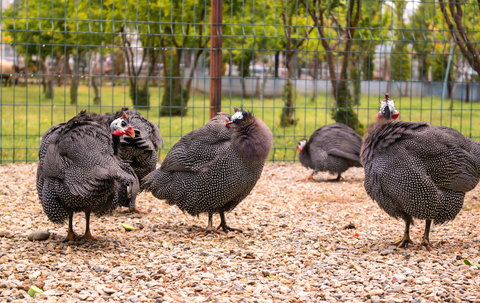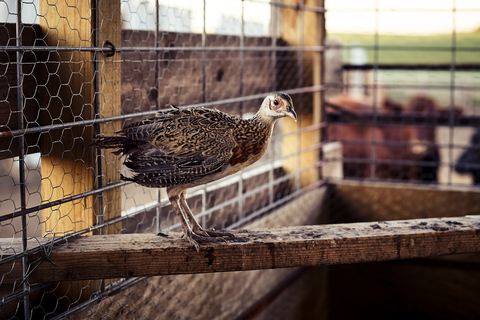Quick facts
- You can raise game birds for show, meat production or for release.
- Unless you make a large initial investment, the market will be mostly local in nature.
- Special considerations are necessary to raise these wild birds in a commercial situation.
Usually people raise game birds and other exotic fowl for one of three reasons: show or exhibition, meat production or release followed by hunting. Game birds are fowl that have an established hunting season. These birds include:
Wild turkeys
Pheasants
Quail
Partridge
Mallards
There are three stages of production for game birds including production of hatching eggs, production of chicks and raising chicks for market or release. The following are key considerations and tips when raising game birds.
Marketing
Game bird producers usually sell to local customers but also to processors and restaurant trade. When making arrangements for marketing, check with customers for any specific requirements they may have concerning inspection and dressed weight. Make sure you have a market established prior to investing in the start-up of a production unit. Maintaining good carcass quality will be essential to future sales.
Consumer demand for the meat is somewhat seasonal and relates loosely with the November and December holidays.
Economics
Production costs of game birds are similar to other types of poultry. You’ll want to consider the following costs before starting production.
Bird housing
Land
Equipment
Chick costs
Feed
Litter
Fuel
Electricity
Medication
Labor
Taxes
Depreciation
Interest
Keeping complete records on costs is the only way for you to evaluate the profitability of your operation. Feed and chick costs represent 80 percent of the total production cost. Another major equipment expense is the feeding and watering system.
Housing costs depend on the bird’s intended use. Game birds raised for release need to be conditioned in totally enclosed flight pens prior to release. In either case, a heated brooder facility is necessary. During brooding, brooder stoves provide added heat.
Income
At the retail level, pheasants have sold for $2 to 3 per pound of dressed weight. Your return will then depend on the production cost to raise birds to market weight. You can expect pheasant hens and roosters to reach the following weights by 16 to 18 weeks of age.
Hens
Live weight: 2.5 to 3 pounds
Dressed weight: 2 to 2.25 pounds
Roosters
Live weight: 3.0 to 3.5 pounds
Dressed weight: 2.25 pounds
Birds will need to consume about 13.25 pounds of feed before reaching market weight.
Guinea fowls are ready for market at 2.75 to 3.25 pounds at 15 to 18 weeks of age. They require about 10 pounds of feed. Mortality may range from 10 to 20 percent.
Setting up the brooder
You can prepare the brooding facility by cleaning and disinfecting the building as well as making it pest proof. Place a 2- to 3-inch base of clean absorbent litter such as wood shavings in the pen.
You can set up a brooder ring by placing an 18-inch-high barrier of corrugated cardboard chick guard in a 10- to 12-foot diameter circle with a standard hover-type brooder stove hung in the center. Place feeders and waterers around the edge of the stove.
Prior to chick arrival, adjust the temperature to 95 F underneath the brooder at chick height. You can reduce the temperature by 5-degree increments each week after the first week. You can place five-hundred chicks per stove.
Pheasants are very sensitive to disturbances. Keep noise to a minimum and make sure other birds are kept off the farm. Beak trimming is often employed to control cannibalism.
Providing space
From 0 to 6 weeks of age, each bird needs 1 square foot of floor space. Provide 1 linear inch of feeder space per chick and increase it to 2 to 3 inches by the sixth week. Start with two 1-gallon fountains per 100 chicks or 100 inches of water trough space. At the sixth week, provide two 3-gallon fountains or 300 inches of trough space per 100 birds.
At 6 weeks of age, place birds intended for release in flight pens. A flight pen size of 75 feet by 150 feet by 6 feet will handle 400 to 500 pheasants.
Feeding
You should feed a game bird starter diet from 0 to 6 weeks of age and a grower diet from 7 to 12 weeks of age. A starter diet will contain about 28 percent protein, while a grower diet will contain about 22 percent. A lower protein, lower energy diet is then fed to birds intended for release after 12 weeks of age.
You can begin some whole grain feeding at 6 weeks of age. Grit can be fed free choice to birds in outside runs or those being given whole grains. You should continue meat birds on a 22 percent protein diet until market age.
Controlling diseases and parasites
Diseases and parasites common to other poultry can also infect gamebirds. Avian influenza, coccidiosis, blackhead, and round worms can infect game birds and cause harmful results. Keeping your flock’s area clean, minimizing crowding, and having a proper vaccination and medication program can help control disease.
With proper care and disease control practices, you should have a well-fleshed and well-feathered bird for processing. Pin feathers on carcasses from poorly feathered or immature birds will decrease carcass quality.
Inspection and permitting
Meat inspection usually isn’t required for game birds. Please consult with the United States Department of Agriculture (meat and poultry inspection service) and State Department of Agriculture (food inspection, labels and standards) for questions concerning inspection and custom processing.
You may need a permit from the state depending on the eventual use of the game birds you raise. Check with the license bureau of the State Department of Natural Resources for further information concerning the need for a game farm permit and associated regulations.
Reviewed in 2018



